Typical China's Blog
- Home
- Blog
- Fujian Cities
- History of Xiamen

History of Xiamen
- Sophie
- 7/20/2018
- Fujian Cities
Xiamen in Fujian Province used to be known by Europeans and North Americans as "Amoy". The name comes from the dialect that was spoken by the people there. The people of this region - south Fujian and Taiwan - speak Hokkien, a dialect that is still widely spoken by locals. Although today, Mandarin is the common language for business and schools.
Ancient Seaport
The coastal cities of Fujian, including Quanzhou (today a city of over 7 million that you've likely never heard of), were extremely active port cities. Quanzhou was China's busiest port in the Tang Dynasty. Marco Polo remarked on its vast trade in his travel memoir.
Xiamen was a busy seaport starting in the Song Dynasty. Later, It became an outpost and refuge for Ming loyalists fighting the Manchu Qing Dynasty. Koxinga, son of a merchant pirate set up his anti-Qing base in the area and today a large statue in his honor looks out over the harbor from Gulang Yu island.
Arrival of Europeans
Portuguese missionaries arrived in the 16th century but were quickly kicked out. Later British and Dutch traders stopped in until the port was closed to trade in the 18th century. It wasn't until the First Opium War and the Treaty of Nanking in 1842 that Xiamen was re-opened to the outside when it was established as one of the Treaty Ports open to foreign tradesmen.
At that time most of the tea that left China was shipped out of Xiamen. Gulang Yu, a small island off of Xiamen, was allotted to the foreigners and the whole place became a foreign enclave. Most of the original architecture remains. Stroll down the streets today and you can easily imagine you are in Europe.
The Japanese, World War II and post-1949
The Japanese occupied the area (the Japanese were already in Taiwan, then Formosa, beginning in 1895) from 1938 to 1945. After the Japanese were defeated by the Allies in WWII and China came under Communist control, Xiamen became a backwater.
Chiang Kai-Shek took the Kuomintang and most of China’s national treasures across the Strait to Taiwan and so Xiamen became the front line against an attack from the KMT. The People's Republic of China didn’t develop the area for fear that any development or industry would be attacked by their enemies, now ensconced in Taiwan.
And across the strait, Taiwan’s Jinmen Island, just a few kilometers off the coast of Xiamen, became one of the most heavily armed islands in the world as Taiwanese feared attack from the mainland.
1980s
After Deng Xiaoping’s led Reform and Opening, Xiamen was reborn. It was one of the first Special Economic Zones in China and received heavy investment not only from the mainland but also from businesses from Taiwan and Hong Kong. As tensions between mainland China (the PRC) and KMT-controlled Taiwan began to relax, Xiamen became a haven for businesses coming to the mainland.
Present-day Xiamen
Today Xiamen is seen by Chinese as one of the most livable cities. The air is clean (by Chinese standards) and people there enjoy a relatively high standard of living. It has large swathes of green space and the coastline has been developed for recreation – not only beach play but also long stretches of jogging paths, rare in Chinese cities. It is also a gateway to visit the rest of Fujian Province, an area popular with Chinese and foreign tourists alike.
Comments